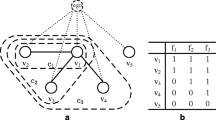Abstract
In recent years, social networks have surged in popularity as one of the main applications of the Internet. One key aspect of social network research is exploring important unobserved network information which is not explicitly represented. This study first introduces a new path identification problem to identify the existences of unobserved paths between nodes. Given a partial social network structure where the indications of observed nodes about unobserved paths are assumed to exist, we propose a multiple-level classification based path identification method (MCPIM) for graph-based social networks. MCPIM presents the new multiple-level similarity to efficiently represent the structural positions of subgraph placeholders. Subsequently, a quantum mechanism based genetic classification algorithm (QGCA) is constructed to efficiently divide subgraph placeholders into different clusters. The nodes whose subgraph placeholders are in the same cluster owning large structural similarities are inferred to have unobserved paths. Results obtained by comparing with state-of-the-art methods via extensive experiments using disparate real-world social networks show that MCPIM can well identify the existences of unobserved paths between nodes in graph-based social networks.


Similar content being viewed by others
References
Aggarwal, C., Subbian, K.: Evolutionary network analysis: a survey. ACM Comput. Surv. 47(1), 10 (2014)
Bai, X., Latecki, L.: Path similarity skeleton graph matching. IEEE Trans. Pattern Anal. Mach. Intell. 30(7), 1282–1292 (2008)
Bütün, E., Mehmet, K., Reda, A.: Extension of neighbor-based link prediction methods for directed, weighted and temporal social networks. Inf. Sci. 463-464, 152–165 (2018)
Cho, E., Myers, S.A., Leskovec, J.: Friendship and mobility: user movement in location-based social networks. SIGKDD. (2011)
Clauset, A., Moore, C., Newman, M.E.J.: Hierarchical structure and the prediction of missing links in networks. Nature. 453(7191), 98–101 (2008)
Eyal, R., Rosenfeld, A., Sina, S., et al.: Predicting and identifying missing node information in social networks. ACM Trans. Knowl. Discov. Data. 8(3), 1–35 (2013)
Feng, X., Zhao, J.C., Xu, K.: Link prediction in complex networks: a clustering perspective. Eur. Phys. J. B. 85(1), 3 (2012)
Girvan, M., Newman, M.: Community structure in social and biological networks. Proc. Natl. Acad. Sci. U. S. A. 99(12), 7821–7826 (2001)
Gleiser, P.M., Danon, L.: Community structure in Jazz[J]. Adv. Complex Syst. 6(04), 565–573 (2003)
Guimerà, R., Sales-Pardo, M., Amaral, L.A.: Classes of complex networks defined by role-to-role connectivity profiles. Nat. Phys. 3(1), 63–69 (2006)
Kand, M., Jure, L.: The network completion problem: inferring missing nodes and edges in networks. SDM. (2011)
Klimt, B., Yang, Y.: The Enron Corpus: A New Dataset for Email Classification Research. European Conference on Machine Learning (2004)
Konar, D., Bhattacharyya, S., Sharma, K., Sharma, S., Pradhan, S.R.: An improved hybrid quantum-inspired genetic algorithm (HQIGA) for scheduling of real-time task in multiprocessor system. Appl. Soft Comput. 53, 296–307 (2017)
Leskovec, J., Kleinberg, J., Faloutsos, C.: Graph evolution: densification and shrinking diameters[J]. ACM Trans. Knowl. Discov. Data. 1(1), 2 (2006)
Leskovec, J., Lang, K.J., Dasgupta, A., Mahoney, M.W.: Community structure in large networks: natural cluster sizes and the absence of large well-defined clusters. Internet Math. 6(1), 29–123 (2009)
Leskovec, J., Huttenlocher, D., Kleinberg, J.: Predicting Positive and Negative Links in Online Social Networks. WWW (2010)
Li, X.L., He, X.D.: A hybrid particle swarm optimization method for structure learning of probabilistic relational models. Inf. Sci. 283, 258–266 (2014)
Liu, Y., Slotine, Y., Barabasi, A.: Controllability of complex networks. Nature. 473(7346), 167–173 (2011)
Lü, L., Zhou, T.: Link prediction in complex networks: a survey. Physica A: Statistical Mechanics and Its Applications. 390(6), 1150–1170 (2011)
Lü, L., Pan, L., Zhou, T., Zhang, Y.C., Stanley, H.E.: Towards link predictability of complex networks. Proc. Natl. Acad. Sci. U. S. A. 112(8), 2325–2330 (2015)
Mcauley, J., Leskovec, J.: Learning to discover social circles in Ego networks. NIPS. (2012)
Meng, Y., Liu, X.: Quantum inspired evolutionary algorithm for community detection in complex networks. Phys. Lett. A. 34(31), 2305–2312 (2018)
Newman, M.E.J.: Finding community structure in networks using the eigenvectors of matrices. Phys Rev E. 74(3), 036104 (2006)
Richardson, M., Agrawal, R., Domingos, P.M.: Trust Management for the Semantic Web. ISWC (2003)
Salespardo, M., Roger, G., Moreira, A.A., et al.: Extracting the hierarchical organization of complex systems. Proc. Natl. Acad. Sci. U. S. A. 104(39), 15224–15229 (2007)
Sett, N., Basu, S., Nandi, S., et al.: Temporal link prediction in multi-relational network. World Wide Web-internet and Web Information Systems. 21(2), 395–419 (2018)
Swingle, B., Bentsen, G., Schleier-Smith, M., Hayden, P.: Measuring the scrambling of quantum information. Phys. Rev. A. 94, (2016)
Wang, H., Hu, W., Qiu, Z.: Nodes’ evolution diversity and link prediction in social networks. IEEE Trans. Knowl. Data Eng. 29(10), 2263–2274 (2017)
Wang, Y., Feng, C., Chen, L., et al.: User identity linkage across social networks via linked heterogeneous network embedding. World Wide Web. (2018)
Wang, Y., Ma, F., Jin, Z., et al: EANN: Event adversarial neural networks for multi-modal fake news detection. SIGKDD (2018)
Wang, H., Wu, J., Hu, W., et al.: Detecting and assessing anomalous evolutionary behaviors of nodes in evolving social networks. ACM Trans. Knowl. Discov. Data. 13(1), 1–24 (2019)
Yi-Cheng, C.: A novel algorithm for mining opinion leaders in social networks. World Wide Web. 22(3), 1279–1295 (2018)
Yu, K., Chu, W., Yu, S., et al.: Stochastic Relational Models for Discriminative Link Prediction. International Conference on Neural Information Processing Systems. MIT Press (2006)
Funding
This work is supported by the Key Special Project National Key R&D Program of China(2018YFC1604000), Chongqing Natural Science Foundation Project (cstc2020jcyjmsxm1593), and Independent Science and technology Innovation Fund project of Huazhong Agricultural University (2662019QD047).
Author information
Authors and Affiliations
Corresponding author
Additional information
Publisher’s note
Springer Nature remains neutral with regard to jurisdictional claims in published maps and institutional affiliations.
Rights and permissions
About this article
Cite this article
Wang, H., Ni, Q., Wang, J. et al. Existence identifications of unobserved paths in graph-based social networks. World Wide Web 24, 157–173 (2021). https://doi.org/10.1007/s11280-020-00837-4
Received:
Revised:
Accepted:
Published:
Issue Date:
DOI: https://doi.org/10.1007/s11280-020-00837-4




